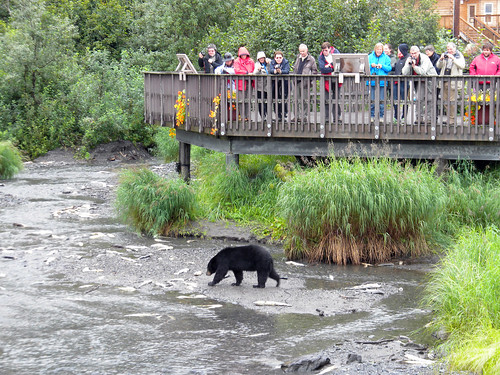
The City of Valdez, Alaska, offers a unique destination for visitors because of the proximity to the Crooked Creek Information Center, the most visited information center on the Chugach National Forest. Situated alongside the creek, a fish viewing platform beckons guests to take in the salmon returning to spawn each summer.
So what if you can’t make it to Alaska this summer? You can still experience the wonder through the Crooked Creek underwater fish cam.
An underwater camera has offered images of the swimming fish at Crooked Creek for several years; however, it was only linked to a monitor on the fish viewing platform. Visitors could get the bird’s-eye view of the creek from the platform, and then watch the fish underwater on the monitor. This summer, Andrew Morin, a fisheries biologist in Cordova, joined other Chugach employees to make the Crooked Creek fish cam available to the world via the Forest Service YouTube live streaming video.
In Alaska, many visitors travelling the 368-mile Richardson Highway which connects Valdez with Fairbanks stop at the center to talk with Jeannie Kirkland and Bonnie Thiel, the center’s interpretive rangers. Kirkland and Thiel share stories, facts and information about camping and hiking opportunities in Prince William Sound. They also help keep the camera running so viewers can see the fish migrating in to the site.
“Jeannie and Bonnie are vital to the day-to-day operation of the camera,” Morin said. “Because the camera can easily get buried under the gravel being moved by the spawning salmon, their help in brushing away the pebbles and vegetation that obscure the camera allows a clean image to be transmitted.”
Valdez’s efforts to live stream their camera were inspired by Pete Schneider from the Juneau Ranger District, Tongass National Forest, and Donovan Albert from the Forest Service Office of Communications. The first Forest Service live streaming salmon cam from Steep Creek in Juneau is also currently running. Thousands will enjoy the salmon’s annual pilgrimage and learn more about the fish activity through Morin’s interactive commentary on the site. Given the rave reviews for the Juneau cam, Schneider led efforts to duplicate it in Valdez. Crooked Creek lends itself well to a salmon cam project.
“Valdez has long days in the summer, so there’s lots of light for the camera” said Morin. “Not only that, but we have three separate species of salmon that spawn in the creek, so the fish are here from July to October.”
The pinks are the first to arrive. They are the smallest of the three species, and the males develop distinctive humps on their backs, indicating their nickname “humpback salmon.” Later in July, the chum salmon appear. Chums are generally much larger than the pinks and have tiger stripes on their sides when they spawn. In mid to late August, the Coho, or silver salmon arrive. The adults typically move in on the high tides, which vary from day to day. Higher water levels make it easier for them to move into the creek.
Crooked Creek has very little impact from development. Like many streams in Alaska, it has clean, cold water that contains a lot of oxygen, an important component of a healthy fish habitat. A small waterfall situated just above the viewing platform accentuates a picturesque setting.
“The falls increase the amount of air in the water, which provides more oxygen for the fish to breath,” Morin said. “That’s good for the eggs, too. The water filters down into the gravel and keeps the eggs healthy as they grow and develop.” He will monitor and respond to the Forest Service YouTube site and responding to comments from the public as time permits.
“It’s a great way to reach out to people.” Morin continued, “It will encourage those who have always wanted to come to Alaska and see salmon in the wild to make the trip. But don’t get your fishing poles out, that area of the creek is reserved for bears to fish.”
Employed on the Chugach since 2012, he is one of several employees assigned to the Prince William Sound Zone, which includes more than four million acres and encompasses all of Prince William Sound and the Copper River Delta.
Morin’s work with stream and lake habitat improvement projects includes field work with Pacific Northwest Research Station researchers to examine the ecological impacts of an invasive aquatic plant called Elodea on the fish and invertebrate communities found on the forest and its environs.
